Minnesota/Minnesota highway classification/Helper keys
Still to do: correctly format links implied here and add information about the queries performed.
The term "helper keys" has been coined to loosely classify a group of new keys that are being used to assist in the MN highway classification project. Whether these keys actually prove useful and for how long they remain useful is to be determined. This page provides an overview of the keys and the reasons for their existence. Refer both to the Minnesota highway classification main page and Key description wiki pages for each key. In this summary page overpass turbo was used to select OSM objects that have the key and render the results. GeoJson files (for example) could be exported from overpass turbo and uploaded to the ID editor, for example.
Purpose
These keys are all intended to help the mappers who are reclassifying the highways in Minnesota. Some of these keys are useful to support the early phases of inventorying and analyzing the cities and highways in Minnesota. Some are useful in helping visualize proposals for changes. Some are useful during the map updating process. The summary descriptions of the keys are below. For key details look at the Key:<key name> pages for each of the keys.
Summary descriptions
These descriptions only provide top level information about the keys. There is no particular order for the these descriptions. Refer to specific Key: wiki pages for more details.
Keys used on boundaries of cities
All of these keys are used on boundaries of cities.
MN city tier (regional centers)
Applied to the entire boundary of cities, this key is used throughout the state of Minnesota to tag the entire boundaries of the cities considered by the classification project as possible regional centers. This allows a zoom out of the important cities in Minnesota and a zoom in (if needed) for seeing the specific boundaries of all those cities.
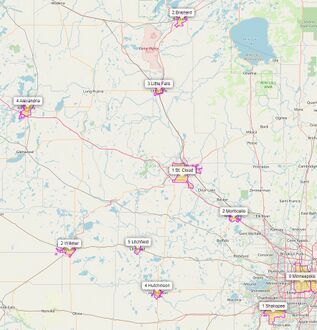
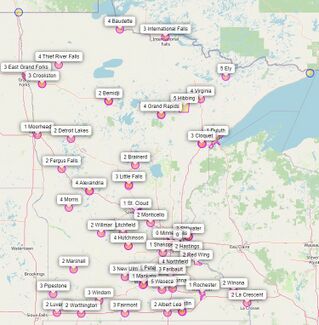
MN metro (metropolitan areas)
This is also applied to the entire boundaries of cities. (See a county boundary use variant of this key below). Anticipating that different guidelines might be needed for metropolitan areas such as the Twin Cities, it was thought useful to show either all of the metro area, or at least the "edge cities" of a metro area. Currently MN_metro=TC is used in the latter way. It shows fairly cleanly the outer most part of of the Twin Cities metro area. The example image below shows use of this approach.
While deciding where the Twin Cities metro area should end for our classification project, we also used this key to mark the boundaries of counties. While this variant is still in use, the team decided to use city boundaries rather than county boundaries. The county boundary variant (for the Twin Cities) is tagged: MN_metro=TC_county.
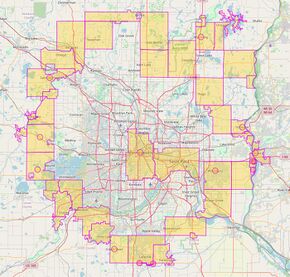
MN_metro=TCMN metro edge (boundary edge of metropolitan areas)
The MN_metro=* key applies to the entire boundaries of the entire set of cities at the perimeter of the metropolitan area. A much smaller definition of the edge of a metro area might also be useful (it is in the process of being rolled out and there is no feedback on its actual usefulness yet). This key is related to the MN_metro_spoke=* key below. While the spoke key shows which highways enter the metropolitan area, this key shows the boundary sections where the highways enter. As such, this key is a very small subset of the MN_metro=* key. It shows only the outside edge of the edge cities, and only shows edges that have highways crossing the edge. The results are not pretty, but it might be useful while editing a road that enters the metropolitan area to have a visible clue about when you should be thinking about whether to follow specific metro guidance instead. Currently the edge tagging decision was based only on highway=* for motorway, trunk, primary, or secondary.
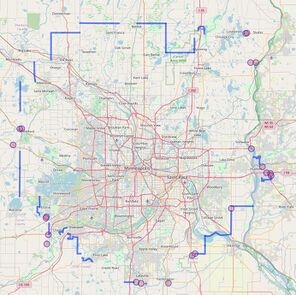
MN_metro_edge=TCKeys used on highways
All of these keys are used on highways.
MN metro spoke (highways entering metropolitan areas)
This key is used to mark the segments of a highway that are close to entering a metropolitan area. In general this key is not used inside the metro area. The distance this key is used away from the metropolitan area is not specified. In some cases it is just a small length, like 100 meters. In other cases it might be as long as 1 kilometer or more. This key can be used along with the MN_metro_edge=* key, but the resulting mashup might be confusing. Currently highways are tagged with this if they are any of motorway, trunk, primary or secondary.
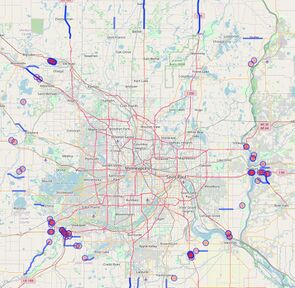
MN_metro_spoke=TCMN to trunk (trunk highway proposals)
This key is used to identify portions of ways that are being proposed as possibly trunk highways. On any one proposed highway trunk segment (e.g. 1a), only a few parts of the segment are keyed. Just enough, probably, for you to see generally where the segment is. You, as mapper will have to carefully review the entire segment (e.g. 1a) whether or not it has this flag. These tags just get you to the right area of the OSM base map.
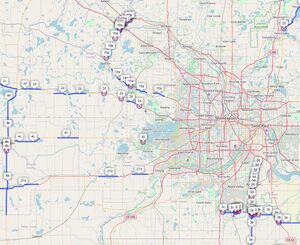
MN_to_trunk=*MN to expressway (expressway analysis)
On 7 March 2022 the use of this key has been discontinued. This key description page and this write-up will continue to exist for a short time in case it is decided to revive its use
This key is to identify highways that are either currently identified as expressways in Minnesota or maybe should be considered. This key is expected be used only a short amount of time. See the key information page for values allowed
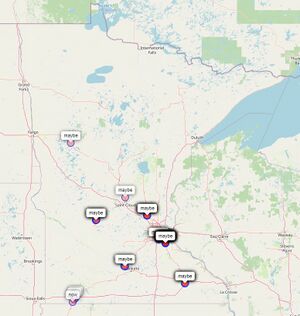
MN Mway island (catalog of existing motorway islands)
This key was used in a detailed analysis of existing motorway islands. The analysis was done to identify which islands should continue to be classified as motorway versus which should be classified as trunk instead. Currently this key will be retained in OSM because it helps document for future mappers that this segment of highway was specifically analyzed and a consensus was achieved about how it should be classified
Values used for these keys
MN_city_tier=* has values corresponding to the specific tier of the city from zero through five.
MN_to_trunk=* has values corresponding to the segments named in the trunk highway proposal. Refer to the proposal. Value examples are 26b, 9, 5f1, and A.
MN_to_expressway=* has two values currently in use. See the Key page for current values.
MN_Mway_island=* has numerous values corresponding to a contrived motorway "island ID". Refer to the Motorway island survey results and conclusions for the island IDs.
All other keys typically have the value TC for "Twin Cities" metro area. Other values may be used in the future (e.g. SC for "St. Cloud" metro area) if it is felt different guidelines are needed in other metro areas in addition to the Twin Cities. As explained above, MN_metro=* also uses the value TC_county.